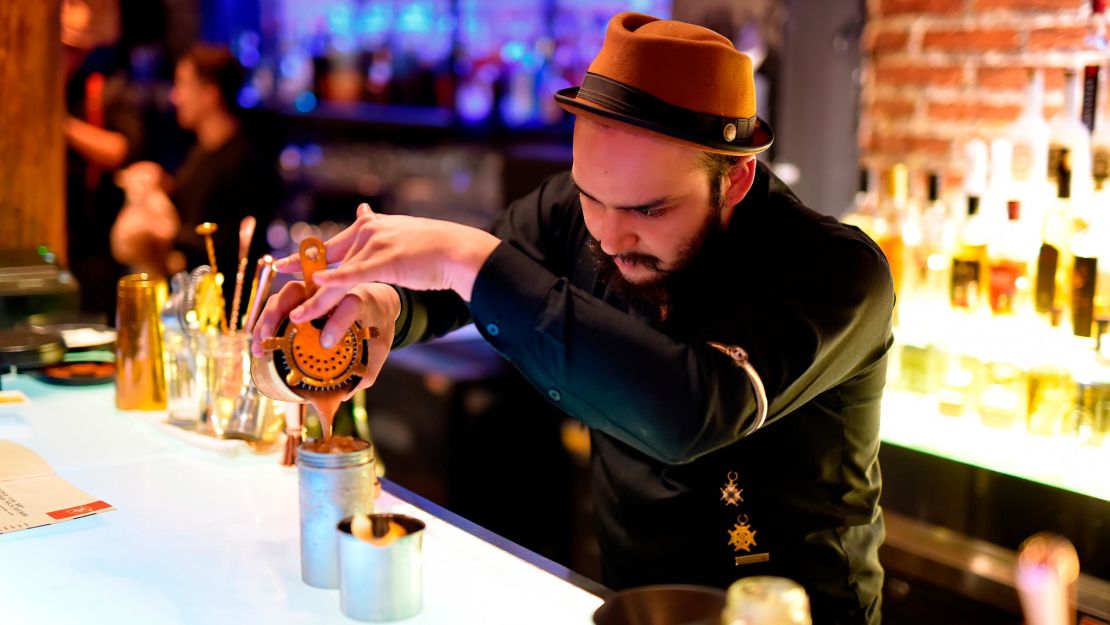Chile and Peru used to be friends. Both stretched along the western coastal edge of South America. Chile even helped its northern neighbor win independence from Spain’s monarchy in the early 1800s.
But since the contentious War of the Pacific in 1879, the two countries have been bitterly divided over border disputes, soccer rivalries, various perceived slights and – perhaps closest to the hearts of both peoples – the invention of the South American spirit pisco, and its most perfect mixological expression, the pisco sour.
Many historians believe that pisco, an unaged grape brandy, was first made in Peru, a stance validated by the European Commission’s decision in 2013 to grant Peru claim to geographical origin of the distilled spirit.
But that has hardly settled the debate.
Last year, Pablo Lacoste, a professor at the University of Santiago de Chile, and a group of colleagues issued a report arguing that Chile had the first commercial trademarks and legal recognition of the spirit. He’s also argued that the proofs Peru have used are false or misunderstood.
Taking the wrong side in either country can lead to shouting matches.
At stake in the hot-blooded dispute is not merely the economic benefits accrued to the county which can boast place of origin – something the vignerons of Champagne, France, could tell you about – but a sense of national pride and identity.
Pisco is “like a treasure map to penetrate the depths of history,” says Lacoste – a deep vein connecting generations.
For Peruvians and Chileans, pisco is often bound up with some of the earliest memories of family and culture. Lacoste’s own preoccupation with the spirit began at age 18, when he traveled to Chile from Argentina on vacation and sipped piscolas – the then-fashionable highball – on the hot, wave-swept beaches of Viña del Mar.
For pisco enthusiast and Peruvian chef Nico Vera, author of the blog Pisco Trail, the initial encounter occurred at an even tenderer age. He had his first taste of pisco at around 12, when he mistook a pitcher of pisco sour that his father had mixed on a steamy summer day for lemonade.
“I served myself a tall glass and slammed it,” says Vera. “It was extremely memorable: delicious, powerful, with a strong kick. It’s been a sentimental favorite ever since.”
The cocktail’s origins

Perhaps unsurprisingly, the invention of the pisco sour – at base, a trio of pisco, citrus and sweetener – has also been a matter of contention between Peru and Chile.
At one point a theory began circulating that the cocktail had been created in the Chilean city of Iquique in 1872 by a British-born man, Elliot Stubb. That idea has since largely been disproved, most vociferously by author Guillermo Toro-Lira.
Lacoste, however, points to an 1822 book which he argues contains a reference to a Chilean pisco sour.
Most accounts of the pisco sour date back to the American expat Victor V. Morris, whose popular Lima watering hole, Morris Bar (opened in 1916), provides us with the first widely publicized references to the pisco sour in the 1920s.
Employees who went on to work at other establishments in the city subsequently honed the drink and it went on to assume its modern incarnation: beautifully balanced, fluffy with egg white, splashed with bitters.
But even this origin story has been upended, with the discovery in recent years of a 1903 cookbook of Peruvian cuisine containing a recipe for a cocktail that we today would consider an egg-white pisco sour. It’s unclear whether Morris might have come across this recipe, or created the drink himself as a variation on a whiskey sour.
Given the endless annals of disagreement over both the spirit and the drink, it can be easy to lose sight of the fact that both in fact take different forms in Peru and Chile.
The two countries have varying requirements for the distillation of grapes used in pisco, resulting in often dramatically disparate flavor profiles.
Meanwhile, the typical Peruvian pisco sour is made with lime juice, egg white and bitters, while the traditional Chilean pisco sour often comes sans egg white or bitters and opts for lemon juice.
Katherine Hidalgo – proprietor of Chipe Libre, the most serious pisco bar in Santiago, Chile – finds the entire debate counterproductive. She serves brands from both countries.
“People continue to spend energy, resources and time discussing ‘what is the real origin’ and the world still does not really know pisco. With that, we lose all. Nobody wins.”
Her advice? People on either side should drop the squabbling and just help “people fall in love with pisco, regardless of its origin.”
A classic pisco sour is often love at first sip. Richly textured yet light on its feet, with vibrant lime citrus brightening the pisco’s earthy fruit notes, it’s a delectable aperitif which can also pair quite well with dinner, especially ceviche.
Try this standard recipe and use it for fuel in whatever long-standing debate rages over your family dinner table.
Pisco sour recipe
3 ounces pisco
1 ounce simple syrup
1 ounce lime juice
1 egg white
Angostura bitters
Cube ice
Combine the pisco, syrup, lime and egg white in a shaker and shake vigorously for 10 seconds. Open the shaker, fill with ice and shake hard a second time for 8-10 seconds. Strain into a coupe or rocks glass and add a dash and/or dots of bitters to the surface.
Christopher Ross is a Philadelphia-based journalist writing for publications including the Wall Street Journal Magazine, Travel + Leisure and Bloomberg Pursuits.



















